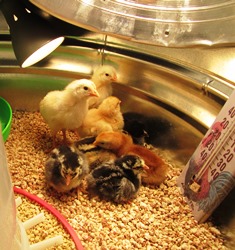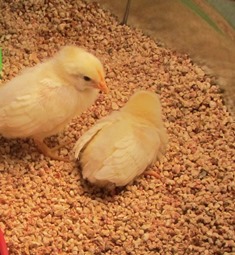Chicklet Therapy: Raising Baby Chicks
I’m raising a flock of baby chicks in a tub in my kitchen. Watching them is nothing short of a stress-busting exercise. Not only do they provide endless entertainment, but they already show individual temperaments and personality traits that can’t help but make you smile.
Some people raise backyard chickens for both meat and eggs. Others want only eggs (I’m in that group). And there are those who love keeping the more exotic breeds–imagine feathered legs and toes, cheek muffs, beards, and strange-looking combs.
There are so many breeds, it’s hard to keep track of them all. For example, there are the standards like the White Leghorns and Rhode Island Reds; the exotics like the Faverolles (with their five toes, feathered feet, and fluffy beards and muffs), and heritage chickens.
Traditional breeds or “heritage” chickens aren’t as popular as they once were, so their numbers are declining. Some are even considered Of the heritage chickens whose numbers are declining so rapidly that they are considered globally endangered. They include Campines, Andalusians, Buttercups, Catalanas, Sumatras, and other breeds.
My baby chick choices include a Rhode Island Red, a Buff Orpington, two Silver-Laced Wyandottes, two White Leghorns, a Black Sex Link, and an Ameraucana (who lays blue-green eggs). All are known to be good layers, although some are more productive than others.
Egg production can go down during periods of molting (losing their feathers) or broodiness (sitting on the eggs as though they will hatch, which they won’t because without a rooster, the eggs are not fertile). Also, egg production can decline during winter when the daylight hours are shorter.
The following guidance comes from my local feed and pet supply store, Concord Feed, Pet, and Livestock Supply. See, http://www.concordfeed.com. The store’s capable staff are all extremely knowledgeable about chicks. Here are the guidelines.
1. The environment must be clean, warm, and dry (no drafts). Consider a brooder’s box or large galvanized tub filled with dry and mold-free bedding such as corn cob shavings (Bed-O-Cobb is a good one). Avoid smooth, slick surfaces that can cause leg damage.
2. They must have room to roam. The rule of thumb is 1 square foot per chick; when they are six weeks and older, given them 2 square feet per bird.
3. Day-old chicks need 90 to 95 degrees Fahrenheit. To achieve this, attach a heat lamp or light bulb about 20 inches above the chicks. When cold, the baby chicks tend to huddle together under the lamp for warmth; when hot, the chicks move to the corners. You will want to reduce the temperature created by the heat lamp by five degrees each week until you reach the ideal temperature of 65 degrees Fahrenheit. Simply move the lamp further away from the chicks.
4. Hydrate the chicks with a one-quart of fresh, cool water in a dispenser that is changed daily (or more often if they scratch bedding or food into it). A quart container will provide enough water for 25 chicks.
5. Feed the babies with a chick starter until they are 16 to 20 weeks old. By that age, they should be feathered completely. Then begin giving the hens a laying feed to help them produce strong-shelled eggs and provide them with the nutrients they require.
By following these guidelines, I think I’ll be able to have eggs from my little hens by August or September this year, barring any of them turning out to be roosters. In case I must give him up (some cities don’t allow roosters), which I wouldn’t want to do, I’ve already talked to the feed store about rooster rescue organization. For helpful information about keeping chickens, see http://www.backyardchickens.com/
 Facebook
Facebook Goodreads
Goodreads LinkedIn
LinkedIn Meera Lester
Meera Lester Twitter
Twitter





